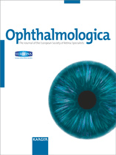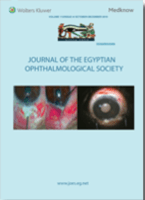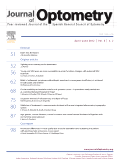
Eye and Vision
Scope & Guideline
Advancing the frontiers of ophthalmology and visual sciences.
Introduction
Aims and Scopes
- Ocular Disease Mechanisms and Management:
Research that elucidates the pathophysiological mechanisms underlying various ocular diseases, including diabetic retinopathy, age-related macular degeneration, and glaucoma, and explores novel therapeutic interventions. - Vision Correction Techniques:
Studies focusing on the efficacy and safety of different vision correction methods, including refractive surgeries, orthokeratology, and intraocular lenses, to improve visual outcomes. - Artificial Intelligence and Imaging:
Exploration of artificial intelligence applications in ophthalmology, particularly in diagnostic imaging and image analysis, to enhance early detection and management of ocular conditions. - Corneal and Retinal Imaging:
Utilization of advanced imaging techniques such as optical coherence tomography (OCT) and fundus photography to assess ocular structures and diagnose diseases. - Myopia and Its Management:
Research dedicated to understanding the mechanisms of myopia progression and evaluating interventions aimed at controlling myopia in children and adolescents.
Trending and Emerging
- Artificial Intelligence in Ophthalmology:
A significant increase in the exploration of AI applications for diagnostic and prognostic purposes, particularly in detecting retinal diseases and automating image analysis. - Myopia Control Strategies:
Growing interest in innovative approaches to manage and mitigate myopia progression, including the use of novel optical devices and pharmacological interventions. - Multimodal Imaging Techniques:
Rising emphasis on utilizing multimodal imaging approaches to enhance diagnostic accuracy and provide comprehensive assessments of ocular conditions. - Telemedicine and Remote Monitoring:
Emerging focus on telemedicine solutions and remote monitoring for eye care, particularly accelerated by the COVID-19 pandemic, reflecting a shift towards accessible patient care. - Biomechanical Properties of the Cornea:
An increasing trend in research examining the biomechanical characteristics of the cornea, especially in relation to keratoconus and refractive surgery outcomes.
Declining or Waning
- Traditional Surgical Techniques:
There is a noticeable decline in papers focusing solely on traditional surgical techniques, such as basic cataract surgery, as the field moves towards more advanced and less invasive methods. - Basic Science Research:
Research papers that delve into fundamental biological or biochemical aspects of eye diseases without immediate clinical implications have decreased, possibly due to a shift towards translational research. - Invasive Diagnostic Procedures:
A reduction in studies involving invasive diagnostic techniques suggests a growing preference for non-invasive imaging methods that provide equivalent or superior diagnostic information.
Similar Journals

Translational Vision Science & Technology
Advancing the Frontiers of Vision Science and TechnologyTranslational Vision Science & Technology is a premier open access journal dedicated to the advancement of the field of ophthalmology and biomedical engineering. Published by the Association for Research in Vision and Ophthalmology, Inc., this journal has established itself as a leading source of high-quality research since its inception in 2013, achieving a remarkable impact factor reflective of its influential contribution to the field. With an impressive ranking of #21 in Ophthalmology and #120 in Biomedical Engineering within the Scopus database, it sits within the prestigious Q1 quartile for both categories as of 2023, further validating its significance. The journal's scope encompasses a wide variety of topics focused on the intersection of ophthalmological science and technological innovation, welcoming contributions that promote the understanding and treatment of visual disorders. Available as an Open Access publication since 2016, it ensures that cutting-edge research is freely accessible to researchers, practitioners, and students worldwide, facilitating the rapid dissemination of knowledge essential for the advancement of vision science.

OPHTHALMOLOGICA
Exploring the Depths of Ocular Health and MedicineOPHTHALMOLOGICA is a prestigious journal published by KARGER, dedicated to the dynamic field of ophthalmology and its interdisciplinary connections with medicine and sensory systems. With a rich history spanning over a century since its inception in 1899, this journal is esteemed for its high-quality research and impactful contributions, maintaining an impressive Q1 quartile ranking in both ophthalmology and miscellaneous medicine as of 2023, alongside a notable Q2 status in sensory systems. The journal's influence is reinforced by its Scopus rankings, where it ranks 26th out of 137 in ophthalmology, showcasing a strong percentile position of 81. Based in Basel, Switzerland, OPHTHALMOLOGICA serves as an essential platform for researchers, professionals, and students, providing essential insights, reviews, and studies that push the boundaries of knowledge in the vision sciences. Although it does not currently offer open access, its contributions are critical for those pursuing advancements in ocular health and related disciplines.

Journal of the Egyptian Ophthalmological Society
Championing advancements in the science of vision.Journal of the Egyptian Ophthalmological Society is a premier academic journal dedicated to advancing the field of ophthalmology through high-quality peer-reviewed research. Published by Wolters Kluwer Medknow Publications, this journal plays a critical role in disseminating vital findings and innovations in eye care, fostering knowledge exchange among researchers, practitioners, and educators worldwide. Since its transformation to Open Access in 2014, it has significantly enhanced the accessibility of eye health information, thereby broadening its impact on the global scientific community. With an ISSN of 2090-0686 and an E-ISSN of 2314-6648, the journal aims to tackle contemporary issues in ophthalmology, including clinical practices, public health, and technological advancements in eye care. The journal's commitment to excellence ensures that it remains a vital resource for those looking to contribute meaningfully to this dynamic and crucial field.

BMC Ophthalmology
Pioneering Discoveries in Eye Health and TreatmentBMC Ophthalmology is a premier open access journal dedicated to advancing the field of ophthalmology through the publication of high-quality, peer-reviewed research. Published by BMC in the United Kingdom, this journal has been a vital resource since its inception in 2001 and continuously contributes to the global dialogue in vision science. With an impact factor reflecting its growing influence, BMC Ophthalmology is ranked among the top quartiles (Q2) in both general medicine and ophthalmology, emphasizing its significance in medical research. The journal encourages submissions that explore innovative diagnostics, treatment approaches, and understandings of various ocular diseases, thereby appealing to researchers, clinicians, and students alike. As an open access platform, it ensures that cutting-edge research is not only published but also readily accessible to a worldwide audience, promoting further study and collaboration in this essential area of medicine.

Journal of Optometry
Empowering the optometry community through shared knowledge.The Journal of Optometry, published by Elsevier, is a leading open access journal dedicated to advancing the field of optometry and vision science. With an ISSN of 1888-4296 and an E-ISSN of 1989-1342, this journal serves as a pivotal platform for researchers, practitioners, and academics alike to disseminate and engage with high-quality original research and review articles. As of 2023, the journal holds an impressive Q2 ranking in the Optometry category, demonstrating its influence and relevance, particularly as it ranks #2 out of 12 in the Health Professions - Optometry category on Scopus with an 87th percentile. Since becoming open access in 2008, the Journal of Optometry has prioritized accessibility and the exchange of ideas, enriching the scholarly community and enhancing practical application in clinical settings. The journal welcomes submissions that push the boundaries of ocular research, clinical practices, and the education of optometry professionals, making it an essential resource for anyone invested in the future of eye health.

Journal of Ophthalmic & Vision Research
Connecting Scholars in Ophthalmic ExcellenceThe Journal of Ophthalmic & Vision Research, published by KNOWLEDGE E, stands as a crucial platform for disseminating high-quality research in the field of ophthalmology. With an ISSN of 2008-2010 and an E-ISSN of 2008-322X, this journal fosters open access to valuable insights since 2010, enhancing visibility and reach for researchers globally. Based in Dubai, UAE, it has established a reputation for excellence, reflected in its Q2 ranking in Ophthalmology for 2023 and its position among the top 65th percentile in Scopus. Covering a broad spectrum of topics within ophthalmic science, the journal serves as a vital resource for professionals, researchers, and students by presenting original research, reviews, and case studies that drive innovation and collaboration within the community. As the journal continues to contribute to advancements in eye care and vision sciences, it invites scholars to explore, engage, and publish within its pages, thus enriching the global discourse on ophthalmic health.

Expert Review of Ophthalmology
Exploring the Frontiers of Ophthalmic ResearchExpert Review of Ophthalmology is a leading academic journal published by ROUTLEDGE JOURNALS, TAYLOR & FRANCIS LTD, specializing in the rapidly evolving field of ophthalmology. With its ISSN 1746-9899 and E-ISSN 1746-9902, this journal has been at the forefront of disseminating critical research and insightful reviews since its inception in 2006. Covering a broad spectrum of topics within ophthalmology, it plays a pivotal role in advancing knowledge and practice, especially given its prestigious standings in various quartile rankings, including Q1 in Public Health and Q2 in Immunology and Allergy for 2023. The journal aims to provide professionals, researchers, and students with comprehensive perspectives on contemporary challenges and innovations in ophthalmology. Generously supported by a robust peer-review process, the journal ensures that all published works meet high academic standards, thereby serving as a vital resource for anyone looking to stay informed about the latest developments in eye care and vision science. By bridging research and clinical application, Expert Review of Ophthalmology is essential for those aiming to contribute meaningfully to this critical field.

OPTOMETRY AND VISION SCIENCE
Shaping the Future of Optometry and Vision ScienceOptometry and Vision Science is a premier journal published by Lippincott Williams & Wilkins, dedicated to advancing the field of optometry and ophthalmology. With a rich history dating back to 1905 and a strong emphasis on scientific rigor, the journal has established itself as a vital resource for researchers, professionals, and students alike. Currently ranked in the Q2 category for both Ophthalmology and Optometry, it occupies a significant position in the academic community, as evidenced by its Scopus rankings of #61 among 137 in Medicine - Ophthalmology and #6 among 12 in Health Professions - Optometry. The journal publishes original research, clinical studies, and critical reviews that contribute to the understanding of visual science, the development of innovative practices, and the enhancement of patient care. Although it is not open access, its impactful content is available to subscribers and institutions, fostering a deeper insight into the complexities of vision science. As we approach the journal's centennial milestone in 2024, Optometry and Vision Science continues to reflect the evolving landscape of eye care research and is poised to inspire a new generation of vision scientists.

JAMA Ophthalmology
Illuminating the Path to Better VisionJAMA Ophthalmology, the premier journal in the field of ophthalmology, is published by the esteemed American Medical Association. Renowned for its rigorous peer-review process and commitment to advancing eye health research, JAMA Ophthalmology holds a prestigious position in the scientific community, boasting an impressive impact factor and ranking as Q1 in the category of Ophthalmology. With a Scopus rank of #3 out of 137 in its field and a remarkable 98th percentile, the journal serves as an invaluable resource for researchers, healthcare professionals, and students dedicated to the ophthalmic sciences. Readers can explore a wealth of cutting-edge findings, clinical studies, and review articles that not only contribute to the sustainable advancement of ophthalmic knowledge but also foster innovative approaches in patient care. As we converge into 2024, the journal continues to embrace open access principles, ensuring that groundbreaking research is readily available to a global audience, enhancing collaborative efforts and furthering the development of the ophthalmology discipline.

JOURNAL FRANCAIS D OPHTALMOLOGIE
Elevating clinical practices with cutting-edge findings.JOURNAL FRANCAIS D OPHTALMOLOGIE, published by MASSON EDITEUR, is a prominent peer-reviewed journal that serves as a vital resource in the field of ophthalmology. Launched in 1978, this esteemed publication continues to make significant contributions to the advancement of ocular health and vision science, with its scope encompassing clinical practices, innovative research, and the latest technological advancements in ophthalmic care. Based in France, the journal is recognized in the 2023 category quartiles with a Q3 ranking in ophthalmology, reflecting its dedication to quality scholarship within a competitive landscape, as evidenced by its positioning in the 30th percentile of the Scopus rankings. While it operates without Open Access, the journal remains crucial for professionals, researchers, and students alike, providing a platform for sharing knowledge and fostering collaborations in the global ophthalmological community.